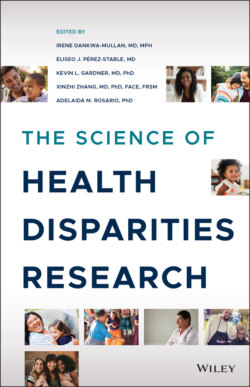Читать книгу The Science of Health Disparities Research - Группа авторов - Страница 32
2.3.2 How We Sleep: Light–Day Cycle, Circadian Clock, and Hypothalamic Linkages to Metabolic Control and Sleep
ОглавлениеThe 24‐hour rotation of the Earth creates a light‐dark cycle that has conditioned the biology and temporal behavior of humans and other mammals to synchronize activities with the 24‐hour clock. This control is exerted in the hypothalamus at the level of the suprachiasmatic nucleus (SCN) (Figure 2.3). In response to temporal cues (or zeitgeber for “time giver”), the SCN executes control of central clock gene function through both endocrine and autonomic outputs. The SCN inputs to the arcuate nucleus, PVN, and LH to cyclically regulate feeding, energy storage, and body temperature [13, 14]. Signals from the SCN are also relayed to the dorsomedial hypothalamus (DMH), which sends significant output to the ventrolateral preoptic nucleus (VLPO), which directly promotes sleep. Its activity is highest during sleep and inhibited by NE and serotonin arising from the arousal network. Thus, timing of sleep, feeding, nutrient intake, times of arousal, and energy expenditure are regulated cyclically (e.g., the early rise of cortisol at the beginning of the day just before activity) [14]. In addition to the SCN, most peripheral cells and tissues express autonomous clocks that function in synchrony with the SCN through the action of a regulatory cassette of clock genes. This regulatory cassette consists of a class of transcriptional activators (Clock/BMAL1) that, in addition to controlling the expression of numerous genes involved in carbohydrate and lipid metabolism, induce the expression of their own repressors (Per1‐3/Cry1‐2) [13].
Besides receiving signals from the SCN, these peripheral clocks are influenced by surrogate zeitgebers other than light, including food availability, glucocorticoids, and temperature. Because of these linkages, it is easy to understand how disruption of this network by environmental changes, such as shift work, jet lag, light pollution, changes in eating patterns, and sleep deprivation, may lead to metabolic imbalance and weight gain. These changes all have the common effect of altering hypothalamic control of processes involved in energy storage and expenditure. Indeed, studies of shift work provide important insights into the linkages between circadian rhythm and metabolism. Studies of individuals experiencing circadian misalignment reveal significantly higher rates of hypoleptinemia, insulin resistance, inverted cortisol peaks, and increased blood pressures. All of these measures are frequently used biomarkers of allostatic load and consistent with the association between poor sleep health and metabolic syndrome, diabetes, and obesity (Figure 2.3) [13, 14].
Notably, these influences appear bidirectional, as patients with diabetes show dampened circadian oscillation of both glucose and insulin. Thus, synchronization of activity, feeding behavior, and sleep with light–dark cycles has significant influence on metabolic imbalance and obesity. As mentioned above, many aspects of these regulatory circuits are likely to have bidirectional effects, since glucocorticoids have a strong influence on the expression of multiple clock genes in the SCN and peripheral tissues [13].
